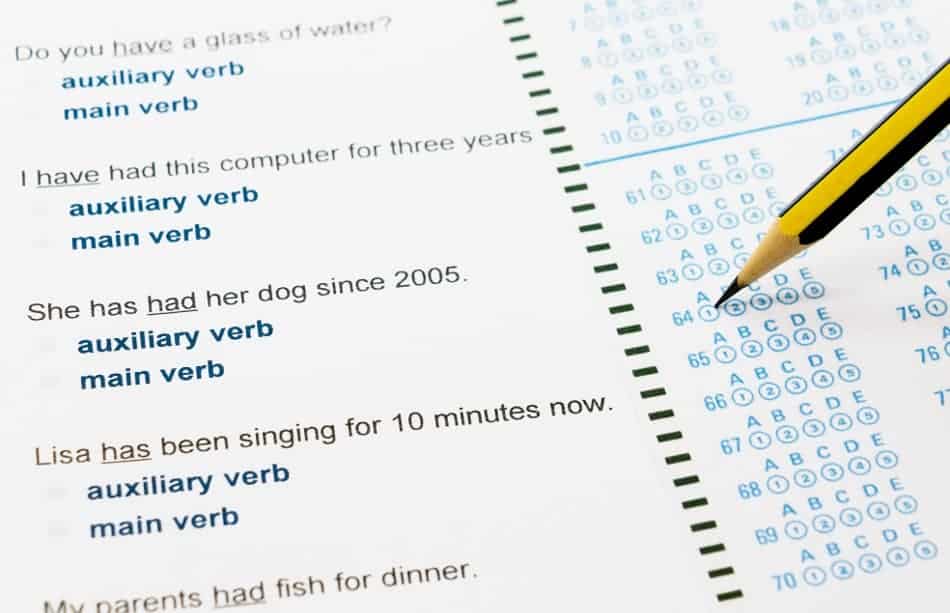I am a person small in stature, which is something my three boys will probably figure out someday. I am not tiny, per se, but I am a bit on the short side. This means that when I need to reach something that’s on the top shelf at the store or even the top shelf in my cupboards at home, I need someone to help me. Or I require the assistance of my trusty step stool I store between the counter and the refrigerator. Just as people sometimes need help with tasks, sometimes verbs need help in conveying meaning such as tense or possibility. This is accomplished through auxiliary verbs, more commonly referred to as helping verbs.
What Do Helping Verbs Do?
Helping verbs work with the main verb to create a verb phrase. There can be no more than three “helpers” in any verb phrase. While linking verbs describe the subject of the sentence, the helping verb provides additional information in respect to the main verb.

List of Helping Verb Examples
When it comes to helping verbs, people have lots of questions. They usually include the following:
- Is “must” a helping verb?
- Is “should” a helping verb?
- Is “is” a helping verb?
- Is “will” a helping verb?
- Is “can” a helping verb?
- Is “not” a helping verb?
- Are helping verbs considered regular verbs? (No, they aren’t.)
Instead of answering these one by one, I made a list to make it easy to identify a helping verb in your writing.
Common Helping Verbs List
| Be | Do | Have |
| Am | Does | Has |
| Is | Did | Had |
| Are | Having | |
| Was | ||
| Were | ||
| Been | ||
| Being |
Modal Helping Verbs List
| Can | Must | Should |
| Could | Ought to | Will |
| May | Shall | Would |
| Might |
Some of these verbs also link with ‘not’ to form a negative. Even when it’s used in a contraction (didn’t, isn’t, shouldn’t), ‘not’ is not considered to be a helping verb.
How To Use Helping Verbs
A helping verb is used in a sentence to create emphasis, the perfect tense, the passive voice, the conditional and questions. In most cases, to form a verb phrase, simply place the helping verb before the main verb.
Emphasis
When used for emphasis, the helping verb doesn’t change tense.
– I could have helped my friend step across the puddle, but it was funnier to watch her trip and fall.
– Although I didn’t know there was a quiz today, I did know all of the answers.
Perfect Tense
Helping verbs are used to construct past perfect, present perfect and future perfect tenses to say what has, is or will be in a progressive state or completed by a certain time. They can also be used to construct the continuous forms for these tenses.
– Past Perfect: Someone had eaten the donut before Drew arrived.
– Past Perfect Continuous: Hope had been writing for hours when the new articles were listed.
– Present Perfect: Once I have written this article, I don’t know what I will do next.
– Present Perfect Continuous: Emilie has been editing articles all night long.
– Future Perfect: I will have visited all 50 states when I go to Hawaii.
– Future Perfect Continuous: I feel like I will have been writing this essay forever when I finally turn it in.
Passive Voice
When constructing a sentence in passive voice, where the subject is acted upon rather than performing the action, a helping verb — a form of be — is required.
– Mike was beaten by Joe in the final word count.
– The movie was watched by hundreds of thousands of anxious viewers.
Conditional
Also known as modal auxiliaries, conditionals include all helping verbs that describe ability, intention, necessity, obligation, permission and possibility. These include can, could, may, might, must, ought to, shall, should, will and would.
– Writers should proofread their work before submitting.
– I can type fast, but not as fast as Jennifer.

Questions
Forming a question is kind of like the irregular structure of a verb phrase including a helping verb. In normal construction, a helping verb comes directly before the main verb. With questions, the subject is usually placed between the auxiliary verb and the main verb.
– Does Amber sleep?
– Can you reach that box on the top shelf for me?
Helping Verbs: Lending a Verbal Hand
When you need to further define information regarding a verb, helping verbs are there to — well, help. What is the auxiliary verb you tend to use the most? What is the most confusing aspect of these words? Let me know in the comments below!


Leave a Reply